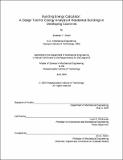Building energy calculator : a design tool for energy analysis of residential buildings in Developing countries
Author(s)
Smith, Jonathan Y. (Jonathan York), 1979-
DownloadFull printable version (769.5Kb)
Other Contributors
Massachusetts Institute of Technology. Dept. of Mechanical Engineering.
Advisor
Leon R. Glicksman.
Terms of use
Metadata
Show full item recordAbstract
Buildings are one of the world's largest consumers of energy, yet measures to reduce energy consumption are often ignored during the building design process. In developing countries, enormous numbers of new residential buildings are being constructed each year, and many of these buildings perform very poorly in terms of energy efficiency. One of the major barriers to better building designs is the lack of tools to aid architects during the preliminary design stages. In order to address the need for feedback about building energy use early in the design process, a model was developed and implemented as a software design tool using the C++ programming language. The new program requires a limited amount of input from the user and runs simulations to predict heating and cooling loads for residential buildings. The user interface was created with the architect in mind, and it results in direct graphical comparisons of the energy requirements for different building designs. The simulations run hour by hour for the entire year using measured weather data. They typically complete in less than two seconds, allowing for very fast comparisons of different scenarios. A set of simulations was run to perform a comparison between the new program and an existing tool called Energy-10. Overall, the loads predicted by the two programs were in good agreement.
Description
Thesis (S.M.)--Massachusetts Institute of Technology, Dept. of Mechanical Engineering, 2004. This electronic version was submitted by the student author. The certified thesis is available in the Institute Archives and Special Collections. Includes bibliographical references (p. 99-100).
Date issued
2004Department
Massachusetts Institute of Technology. Department of Mechanical EngineeringPublisher
Massachusetts Institute of Technology
Keywords
Mechanical Engineering.